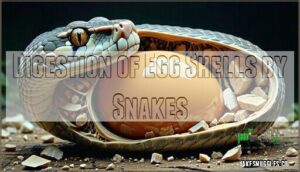This site is supported by our readers. We may earn a commission, at no cost to you, if you purchase through links.

These reptiles dislocate their jaw joints and use flexible throat muscles to swallow eggs much larger than their heads.
Most egg-eating species don’t crush the shell immediately – instead, they guide the whole egg down their throat using rippling muscle contractions.
Once inside, specialized throat projections called gular teeth puncture the egg, allowing the snake to drink the contents before regurgitating the empty shell fragments.
This remarkable feeding strategy lets certain species survive almost entirely on bird eggs, transforming their bodies into living egg-processing machines with fascinating anatomical adaptations.
Table Of Contents
- Key Takeaways
- How Do Snakes Eat Eggs?
- Do Snakes Have Teeth for Eating Eggs?
- How to Identify a Snake Consuming Chicken Eggs
- Digestion of Egg Shells by Snakes
- Mechanism of Egg Laying for Snakes
- Unique Adaptations of Egg-eating Snakes
- Frequently Asked Questions (FAQs)
- What snake eats eggs?
- How to prevent snakes from eating eggs in the chicken house?
- What are egg-eating snakes?
- Where do egg eating snakes live?
- What happens when a snake swallows a boiled egg?
- How to tell if a snake is eating chicken eggs?
- Do snakes that eat eggs have teeth?
- Can snakes choke on eggs?
- How do snakes digest egg shells?
- How do snakes push out eggs?
- Conclusion
Key Takeaways
- You’ll witness snakes dislocate their jaw joints to swallow eggs much larger than their heads, using flexible throat muscles and rippling contractions to guide whole eggs down their throats.
- You can identify egg-eating snakes by their specialized anatomy – they’ve got minimal teeth and internal bony projections called spinal protrusions that puncture shells after swallowing.
- You’ll find these snakes don’t actually digest eggshells but instead extract nutrients from the contents before regurgitating the broken shell fragments through reverse muscle contractions.
- You can spot snake egg theft in chicken coops by looking for missing eggs, snake droppings with shell fragments, shed skins, and nervous chicken behavior around nesting areas.
How Do Snakes Eat Eggs?
Throughout evolution, snake egg eating has become a masterful art form.
When you watch egg eating snakes in action, you’ll notice their incredible jaw flexibility allows them to unhinge their jaws like a door opening wide.
Their jaws unhinge like nature’s ultimate door, opening impossibly wide to swallow eggs twice their head size.
This swallowing mechanism lets them consume eggs much larger than their head diameter.
The snake diet eggs process involves stretching their throat around the entire egg.
Once inside, spinal protrusions – sharp, bony projections along their spine – puncture and crush the shell.
Their esophagus acts like a biological crusher, breaking down shells efficiently.
After crushing, nutrient extraction occurs as they absorb the egg contents while regurgitating empty shell fragments.
This remarkable adaptation explains how snakes consume eggs without chewing, making egg size less limiting than you’d expect.
Some species, like kingsnakes, are known to be ophiophagic, preying on other snakes and their eggs.
Do Snakes Have Teeth for Eating Eggs?
When examining snake anatomy eggs consumption, you’ll discover that egg eating snakes possess fascinating dental adaptations.
These specialized predators actually have minimal or virtually no functional teeth – a condition known as teeth absence that perfectly suits their unique feeding strategy.
Unlike other serpents, snake adaptations eggs consumption involves jaw flexibility that’s truly remarkable.
Their jaws can disarticulate completely, allowing egg ingestion of prey much larger than their head diameter.
The lack of traditional teeth prevents accidental shell puncturing during swallowing.
What’s truly ingenious are the esophageal adaptations these snakes possess.
Spinal protrusions extend into their throat, creating internal cutting mechanisms that crack egg shells after swallowing.
These bony projections act like built-in egg crushers, allowing efficient nutrient extraction.
This snake egg eating mechanism demonstrates nature’s brilliant problem-solving.
The snake jaw flexibility combined with specialized throat structures creates a perfect egg-processing system without needing traditional teeth.
Some species, like the African Egg-Eating Snake, are popular pets due to their docile nature.
How to Identify a Snake Consuming Chicken Eggs
Spotting a snake raiding your chicken coop requires detective work, but the evidence is usually clear. You’ll notice several unmistakable signs when these slithery egg thieves strike.
Missing Eggs top the list of obvious indicators. If your hens are laying regularly but eggs keep disappearing overnight, suspect snake activity. Unlike other predators that leave messy destruction, snakes are neat thieves.
Here are three key identification methods:
- Install Wildlife Cameras near nesting boxes to catch nocturnal snake raids in action
- Look for Snake Droppings and Shed Skin around the coop perimeter
- Monitor Chicken Behavior for signs of stress or agitation near nesting areas
Snake Tracks in dusty areas reveal their presence, though these can be subtle. Check for Snake Droppings containing eggshell fragments—a dead giveaway of recent egg consumption.
If you find eggs with small, puncture-like holes, it’s another sign of snake predation. Your chickens’ nervous behavior often signals danger before you spot the culprit.
Snake Identification becomes easier when you understand their nocturnal feeding patterns and preferred entry points.
Digestion of Egg Shells by Snakes
When you discover missing eggs in your chicken coop, you’re witnessing nature’s most efficient recycling system in action.
Snake digestion transforms every component of an egg into usable nutrition through specialized anatomical adaptations. After swallowing eggs whole, snakes use spinal protrusions extending into their esophagus to crack shells internally. These vertebrae act like built-in hammers, crushing the shell composition while extracting nutritious contents.
Nature’s perfect recycling system: snakes crack shells with built-in bone hammers, waste nothing, and transform eggs into pure nutrition.
The snake’s digestive system separates egg materials from shell fragments with remarkable precision. Notably, these snakes also have specialized belly scales to aid in movement and grip.
| Digestion Stage | Process | Timeline |
|---|---|---|
| Shell Breaking | Spinal protrusions crush egg shell | 15-30 minutes |
| Nutrient Absorption | Proteins and fats absorbed | 2-4 hours |
| Waste Elimination | Empty shell pieces regurgitated | 4-6 hours |
Most snake species completely digest egg contents while regurgitating broken shell pieces. However, specialized egg-eating snakes achieve total calcium intake by dissolving shells entirely. This efficient snake prey eggs processing system demonstrates how snake vertebrae evolved specifically for egg digestion snakes rely upon for survival.
Mechanism of Egg Laying for Snakes
When you think about snake reproduction, approximately 70% of all snake species practice oviparity, meaning they lay eggs rather than giving birth to live young.
The eggshell formation process begins when fertilization triggers development within the female’s oviduct, where specialized shell glands create tough, leathery protective coverings.
Clutch size varies dramatically across species – some snakes lay just a few eggs while others produce over 100.
Their nesting behavior involves careful selection of warm, humid locations like decaying vegetation or underground burrows. The incubation process typically lasts 45-70 days, during which environmental conditions play a vital role.
Here’s what makes snake reproduction fascinating:
- Female snakes can control egg-laying timing based on environmental cues
- Leathery eggshells allow gas exchange for developing embryos
- Most species abandon eggs immediately after deposition
Unlike their egg-consuming relatives, egg-laying snakes demonstrate remarkable maternal instincts through strategic nest site selection. Some species exhibit parthenogenesis in absence of males.
Unique Adaptations of Egg-eating Snakes
Egg-eating snakes showcase nature’s ingenuity through specialized evolutionary adaptations.
These remarkable serpents have developed unique features that enable them to consume eggs efficiently as their primary food source.
Here are four extraordinary adaptations that make egg consumption possible:
- Flexible jaws that unhinge and stretch dramatically to accommodate eggs larger than the snake’s head diameter
- Spinal protrusions with razor-sharp bony projections that pierce and crush eggshells during swallowing
- Reduced dentition preventing accidental puncturing while maintaining smooth egg passage
- Elastic throat muscles facilitating shell digestion and nutrient extraction from consumed eggs
These snake anatomy adaptations demonstrate incredible species diversity among egg-eating snakes worldwide.
Their flexible mandibles aid in consuming large prey.
Frequently Asked Questions (FAQs)
What snake eats eggs?
Rat snakes, corn snakes, and black racers frequently raid nests.
You’ll also find specialized egg-eating snakes from Africa that consume nothing but eggs.
These adaptable predators target chicken coops and wild bird nests alike.
How to prevent snakes from eating eggs in the chicken house?
Mount nesting boxes on smooth metal poles and install stove pipe baffles to block climbing.
Keep grass mowed, remove woodpiles, and secure feed sources that attract mice, which draw snakes to your coop, particularly to block climbing areas and attractants.
What are egg-eating snakes?
Like nature’s own egg specialists, these African serpents are remarkable creatures that’ve evolved exclusively to consume bird eggs.
You’ll find them using flexible jaws and internal bone crushers to swallow eggs whole without teeth, which makes them uniquely adapted to their diet.
Where do egg eating snakes live?
You’ll find egg-eating snakes primarily in Africa, specifically in sub-Saharan regions, with the Dasypeltis genus inhabiting wooded and forested areas across the continent, from southern to East Africa.
What happens when a snake swallows a boiled egg?
Picture a tiny disaster unfolding inside: when you feed a snake a boiled egg, it can’t crush the hardened shell with its spine projections.
Potentially causing choking, regurgitation, or serious digestive blockages requiring veterinary intervention.
How to tell if a snake is eating chicken eggs?
Check for missing eggs, crushed shells, or snake skins in your chicken coop.
Watch for nervous hens, regurgitated eggshells, and unusual droppings.
Wildlife cameras can help catch these sneaky egg thieves in the act, with wildlife cameras being a key tool.
Do snakes that eat eggs have teeth?
Most egg-eating snakes don’t have traditional teeth.
Instead, they’ve evolved specialized bony projections in their throat and spine that help them crack and consume eggs whole, making them unique predators in the snake world.
Can snakes choke on eggs?
About 80% of snake predation occurs at night when they’re most vulnerable to mishaps.
You’ll find that snakes rarely choke on eggs because their specialized anatomy includes flexible jaw joints and internal crushing mechanisms that safely process eggs.
How do snakes digest egg shells?
You’ll find that snakes don’t actually digest eggshells at all.
They’ve got specialized bony protrusions in their throat that puncture and collapse the shell, extracting nutrients before regurgitating the broken fragments.
How do snakes push out eggs?
After consuming an egg, you’ll see snakes use internal bony protrusions along their spine to puncture the shell, extract nutrients, then regurgitate the crushed fragments through reverse peristalsis within minutes.
Conclusion
Picture a snake’s throat expanding like a balloon as it processes its oval meal—this remarkable sight demonstrates millions of years of evolutionary perfection.
Understanding how do snakes eat eggs reveals nature’s ingenious solutions to seemingly impossible challenges.
These reptiles’ specialized anatomy, from dislocating jaws to puncturing throat projections, transforms them into efficient egg-processing machines.
You’ve now discovered the fascinating mechanics behind one of nature’s most impressive feeding strategies, showcasing the incredible adaptability of these remarkable creatures, and their ability to eat eggs as part of their feeding strategies.
- https://www.berrypatchfarms.net/pet-snakes-that-eat-eggs/
- https://www.threads.com/@vincentgrahamwildlife/post/DEjX_fPtB1r
- https://www.reddit.com/r/Damnthatsinteresting/comments/158kfm7/how_do_snakes_swallow_eggs/
- https://a-z-animals.com/blog/snake-teeth-everything-you-need-to-know/
- https://imgur.com/gallery/egg-eating-snakes-dont-have-teeth-instead-they-have-sharp-blade-like-projections-on-vertebrae-that-will-slice-egg-open-qdaKeIs









